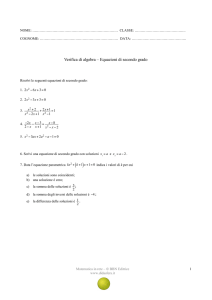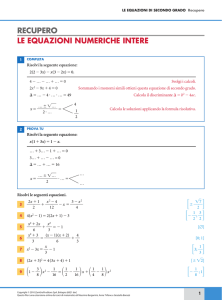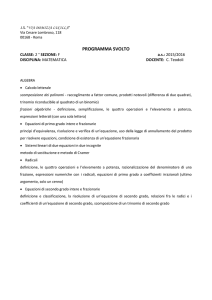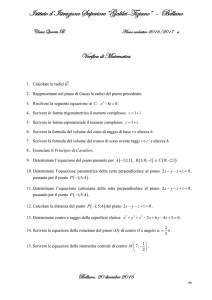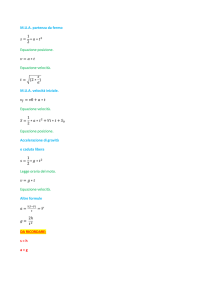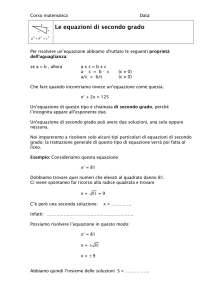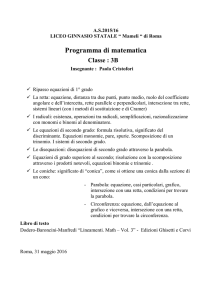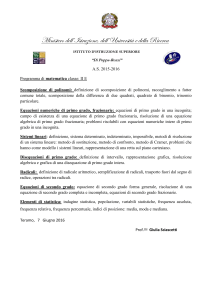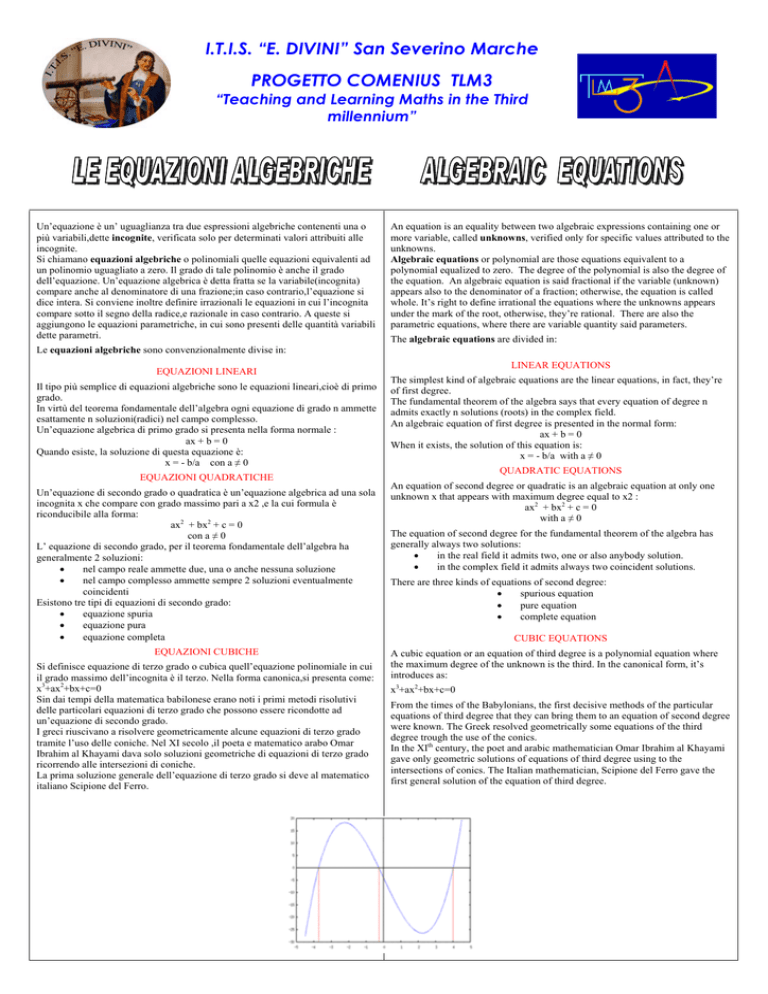
I.T.I.S. “E. DIVINI” San Severino Marche
PROGETTO COMENIUS TLM3
“Teaching and Learning Maths in the Third
millennium”
Un’equazione è un’ uguaglianza tra due espressioni algebriche contenenti una o
più variabili,dette incognite, verificata solo per determinati valori attribuiti alle
incognite.
Si chiamano equazioni algebriche o polinomiali quelle equazioni equivalenti ad
un polinomio uguagliato a zero. Il grado di tale polinomio è anche il grado
dell’equazione. Un’equazione algebrica è detta fratta se la variabile(incognita)
compare anche al denominatore di una frazione;in caso contrario,l’equazione si
dice intera. Si conviene inoltre definire irrazionali le equazioni in cui l’incognita
compare sotto il segno della radice,e razionale in caso contrario. A queste si
aggiungono le equazioni parametriche, in cui sono presenti delle quantità variabili
dette parametri.
An equation is an equality between two algebraic expressions containing one or
more variable, called unknowns, verified only for specific values attributed to the
unknowns.
Algebraic equations or polynomial are those equations equivalent to a
polynomial equalized to zero. The degree of the polynomial is also the degree of
the equation. An algebraic equation is said fractional if the variable (unknown)
appears also to the denominator of a fraction; otherwise, the equation is called
whole. It’s right to define irrational the equations where the unknowns appears
under the mark of the root, otherwise, they’re rational. There are also the
parametric equations, where there are variable quantity said parameters.
The algebraic equations are divided in:
Le equazioni algebriche sono convenzionalmente divise in:
EQUAZIONI LINEARI
Il tipo più semplice di equazioni algebriche sono le equazioni lineari,cioè di primo
grado.
In virtù del teorema fondamentale dell’algebra ogni equazione di grado n ammette
esattamente n soluzioni(radici) nel campo complesso.
Un’equazione algebrica di primo grado si presenta nella forma normale :
ax + b = 0
Quando esiste, la soluzione di questa equazione è:
x = - b/a con a ≠ 0
EQUAZIONI QUADRATICHE
Un’equazione di secondo grado o quadratica è un’equazione algebrica ad una sola
incognita x che compare con grado massimo pari a x2 ,e la cui formula è
riconducibile alla forma:
ax2 + bx2 + c = 0
con a ≠ 0
L’ equazione di secondo grado, per il teorema fondamentale dell’algebra ha
generalmente 2 soluzioni:
•
nel campo reale ammette due, una o anche nessuna soluzione
•
nel campo complesso ammette sempre 2 soluzioni eventualmente
coincidenti
Esistono tre tipi di equazioni di secondo grado:
•
equazione spuria
•
equazione pura
•
equazione completa
EQUAZIONI CUBICHE
Si definisce equazione di terzo grado o cubica quell’equazione polinomiale in cui
il grado massimo dell’incognita è il terzo. Nella forma canonica,si presenta come:
x3+ax2+bx+c=0
Sin dai tempi della matematica babilonese erano noti i primi metodi risolutivi
delle particolari equazioni di terzo grado che possono essere ricondotte ad
un’equazione di secondo grado.
I greci riuscivano a risolvere geometricamente alcune equazioni di terzo grado
tramite l’uso delle coniche. Nel XI secolo ,il poeta e matematico arabo Omar
Ibrahim al Khayami dava solo soluzioni geometriche di equazioni di terzo grado
ricorrendo alle intersezioni di coniche.
La prima soluzione generale dell’equazione di terzo grado si deve al matematico
italiano Scipione del Ferro.
LINEAR EQUATIONS
The simplest kind of algebraic equations are the linear equations, in fact, they’re
of first degree.
The fundamental theorem of the algebra says that every equation of degree n
admits exactly n solutions (roots) in the complex field.
An algebraic equation of first degree is presented in the normal form:
ax + b = 0
When it exists, the solution of this equation is:
x = - b/a with a ≠ 0
QUADRATIC EQUATIONS
An equation of second degree or quadratic is an algebraic equation at only one
unknown x that appears with maximum degree equal to x2 :
ax2 + bx2 + c = 0
with a ≠ 0
The equation of second degree for the fundamental theorem of the algebra has
generally always two solutions:
•
in the real field it admits two, one or also anybody solution.
•
in the complex field it admits always two coincident solutions.
There are three kinds of equations of second degree:
•
spurious equation
•
pure equation
•
complete equation
CUBIC EQUATIONS
A cubic equation or an equation of third degree is a polynomial equation where
the maximum degree of the unknown is the third. In the canonical form, it’s
introduces as:
x3+ax2+bx+c=0
From the times of the Babylonians, the first decisive methods of the particular
equations of third degree that they can bring them to an equation of second degree
were known. The Greek resolved geometrically some equations of the third
degree trough the use of the conics.
In the XIth century, the poet and arabic mathematician Omar Ibrahim al Khayami
gave only geometric solutions of equations of third degree using to the
intersections of conics. The Italian mathematician, Scipione del Ferro gave the
first general solution of the equation of third degree.
I.T.I.S. “E. DIVINI” San Severino Marche
PROGETTO COMENIUS TLM3
“Teaching and Learning Maths in the Third
millennium”
EQUAZIONI QUARTICHE E DI GRADO SUPERIORE
QUARTIC EQUATIONS AND EQUATIONS OF HIGHER DEGREE
Si definisce equazione di quarto grado o quartica quell’equazione in cui il grado
più alto dell’incognita è il quarto. Nella forma canonica,assume la forma:
x4 + ax3 + bx2 + cx + d = 0
L prima soluzione generale dell’equazione di quarto grado di deve al matematico
italiano Ludovico Ferrari, pubblicata però nel 1545 da Gerolamo Cardano.
Solo due secoli e mezzo dopo si dimostrò grazie a Evariste Galois che non
esistevano metodi risolutivi generali per equazioni di grado superiore al quarto.
Infatti i lavori di Paolo Ruffini del 1799 e di Niels Abel nel 1824
costituiscono complessivamente quello oggi noto come
Teorema di Abel-Ruffini. In particolare il torinese Lagrange trovò che il
risolvente di un’equazione di quinto grado è un’equazione di sesto. Il tutto si
ricollega, tramite i lavori di Lagrange, ai risultati di Galois nella teoria di gruppo.
Il metodo risolutivo è imperniato sulla risoluzione di un’equazione di terzo grado,
detta risolvente.
We define equation of fourth degree or quartic that equation where the highest
degree of the unknown is the fourth. In the canonical form, it assumes the form:
x4 + ax3 + bx2 + cx + d = 0
The first general solution of the equation of fourth degree was discovered by
Ludovico Ferrari, the Italian mathematician, published in 1545 by Gerolamo
Cardano.
Only after two centuries and half, Evariste Galois showed that didn't exist
decisive general methods of resolution for equations of degree superior at the
fourth.
In fact the intense activities of Paolo Ruffini of 1824 and of Niels Abel in 1824 in
constitute the Theorem of Abel and Ruffini. Particularly the italian from Turin,
Lagrange found that the equation that resolves an equation of fifth degree is an
equation of sixth degree. Everything is linked, trough the intense activities of
Lagrange, to the results of Galois in the theory of group. The decisive method is
based on the solution of a cubic equation, called resolving.
PARTICULAR EQUATIONS
EQUAZIONI PARTICOLARI
z
EQUAZIONE DIOFANTEA
Un equazione diofantea è un’equazione in una o più incognite con coefficienti
interi di cui si ricercano le soluzioni intere del tipo ax + by = c. L’aggettivo
diofanteo si riferisce al matematico greco del terzo secolo, Diofanto di
Alessandria,che studiò equazioni di questo tipo e fu uno dei primi matematici ad
introdurre il simbolismo nell’algebra. In un’equazione diofantea lineare le
incognite appaiono solo come potenze di primo grado.
z
EQUAZIONI DI PELL
z
DIOFANTEA EQUATION
A diofantea equation is an equation in one or more unknown with whole
coefficients where the whole solutions as ax + by = c are found. The adjective
diofanteo refers to the Greek mathematician of the third century Diofanto from
Alexandria, that studied equations of this kind and he was one of the first
mathematicians to introduce the symbolism in algebra. In a “diofantea” linear
equation the unknowns appear only as powers of first degree.
z
PELL'S EQUATION
Un’equazione di Pell è un’equazione diofantea quadratica in due variabili,del
tipo:
x2 − dy2 = 1 oppure
2
2
Pell's equation is a quadratic “diofantea” equation in two variables, such as:
Una soluzione banale dell’equazione di tipo 1 valida per ogni valore di d è
x = ± 1,
y = 0.
Le equazioni del primo tipo possono avere soluzioni intere per ogni valore di d
che non sia un quadrato perfetto; quelle del secondo hanno invece soluzione
soltanto per alcuni casi particolari.
Il nome deriva da quello del matematica inglese John Pell, al quale Eulero attribuì
il metodo per trovarne le soluzione.
A banal solution of the first equation valid for every value of d is
x=±1
y = 0.
The equations of the first type can have whole solutions for every value of d when
it isn't a perfect square; those of the second have got only solution for some
particular cases.
The naun derives from the name of the English mathematician John Pell. Eulero
attributed to him the method to find its solution.
x − dy = − 1
x2 − dy2 = 1 or
x2 − dy2 = − 1

